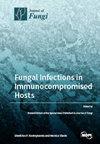转录组学-蛋白质组学综合分析揭示了六叶木贼对长孢假双孢菌感染的反应机制
IF 4.2
2区 生物学
Q2 MICROBIOLOGY
引用次数: 0
摘要
羊肚菌(羊肚菌属)是一种珍贵稀有的食用菌,具有独特的风味和极高的营养价值。在中国,羊肚菌栽培过程中发生的白霉病严重影响了羊肚菌的品质和产量。本研究分离、纯化了导致羊肚菌白霉病的真菌,并通过形态学和分子生物学鉴定其为 Pseudodiploöspora longispora。此外,研究还表明,P. longispora 感染会导致六倍体羊肚菌的子囊皱缩破裂、细胞壁松动、膜明显破损并伴有严重的细胞质渗漏。有趣的是,研究表明,感染 P. longispora 可诱导六角螺虫细胞产生一种未知物质,这种物质会积聚在细胞膜上,导致细胞膜破裂。此外,转录组学-蛋白质组学的综合分析揭示了六角螺虫对长孢霉感染的反应机制。结果表明,在涉及氧化还原酶活性、过氧化物酶体、脂质转运和代谢、细胞壁组装以及膜的整体成分的通路中,DEGs和DEPs可显著富集。进一步的电子显微镜分析明确了细胞膜和细胞壁的变化在菌丝体对生物应激反应中的重要作用。该研究阐明了六角菌对长孢霉的响应机制,为进一步阐明长孢霉的感染机制奠定了基础。本文章由计算机程序翻译,如有差异,请以英文原文为准。
Integrated Transcriptomics–Proteomics Analysis Reveals the Response Mechanism of Morchella sextelata to Pseudodiploöspora longispora Infection
Morels (Morchella spp.) are valuable and rare edible mushrooms with unique flavors and high nutritional value. White mold disease occurring during cultivation has seriously affected the quality and yield of morels in China. In this study, the fungus causing white mold disease in morels was isolated, purified, and identified as Pseudodiploöspora longispora by morphology and molecular biology. In addition, research has shown that P. longispora infection causes wrinkled and rupturing asci, loosened cell walls, and obvious membrane breakage accompanied by severe cytoplasmic leakage in M. sextelata. Interestingly, research has shown that infection with P. longispora can induce the production of an unknown substance in the cells of M. sextelata, which accumulates on the cell membrane, leading to membrane breakage. Furthermore, integrated transcriptomics–proteomics analysis revealed the response mechanism of M. sextelata to P. longispora infection. The results indicate that DEGs and DEPs can be significantly enriched in pathways involved in oxidoreductase activity; peroxisomes, lipid transport, and metabolism; cell wall assembly; and integral components of membranes. Further electron microscopy analysis clarified the important role of changes in the cell membrane and cell wall in the response of mycelia to biological stress. This study clarified the response mechanism of M. sextelata to P. longispora, laying a foundation for further clarifying the infection mechanism of P. longispora.
求助全文
通过发布文献求助,成功后即可免费获取论文全文。
去求助
来源期刊

Journal of Fungi
Medicine-Microbiology (medical)
CiteScore
6.70
自引率
14.90%
发文量
1151
审稿时长
11 weeks
期刊介绍:
Journal of Fungi (ISSN 2309-608X) is an international, peer-reviewed scientific open access journal that provides an advanced forum for studies related to pathogenic fungi, fungal biology, and all other aspects of fungal research. The journal publishes reviews, regular research papers, and communications in quarterly issues. Our aim is to encourage scientists to publish their experimental and theoretical results in as much detail as possible. Therefore, there is no restriction on paper length. Full experimental details must be provided so that the results can be reproduced.
 求助内容:
求助内容: 应助结果提醒方式:
应助结果提醒方式:


